Determining the Spatial Distribution Characteristics of Urban Regeneration Projects in China on the City Scale: The Case of Shenzhen
Abstract
:1. Introduction
2. Literature Review
2.1. UR in China
2.2. Spatial Analysis of UR
2.3. Research Methods for Analyzing Spatial Characteristics
3. Materials and Methods
3.1. Research Framework
3.2. Research Methods
3.2.1. Nearest Neighbor Index and Nearest Neighbor Hierarchical Clustering
3.2.2. Kriging Interpolation
3.2.3. Information Entropy Model
3.2.4. Space Syntax
3.2.5. Kernel Density Estimation
3.2.6. Buffer Analysis
3.3. Study Area
3.4. Materials
4. Results
4.1. Spatial and Temporal Distribution Characteristics of UR
4.2. The Relationship between Public Transportation and the Distribution of UR Projects
4.3. The Relationship between the Urban Population and the Distribution of UR Projects
4.4. The Relationship between House Price and the Distribution of UR Projects
4.5. The Relationship between Urbanization Function and the Distribution of UR Projects
4.6. The Relationship between Urbanization Form and the Distribution of UR Projects
5. Discussions
5.1. The Mixed Methods for Analyzing Spatial Distribution Characteristics of UR in Shenzhen
5.2. The Combination of Top-Down and Market-Driven UR Approaches
5.3. Dilemma of the Center-Periphery Model in UR Implementation
5.4. Barriers of the Industrial Clustering Formation
5.5. Paradox between the Growing Population and the Limited Undeveloped Urban Land
6. Conclusions
Author Contributions
Funding
Institutional Review Board Statement
Informed Consent Statement
Data Availability Statement
Conflicts of Interest
Appendix A
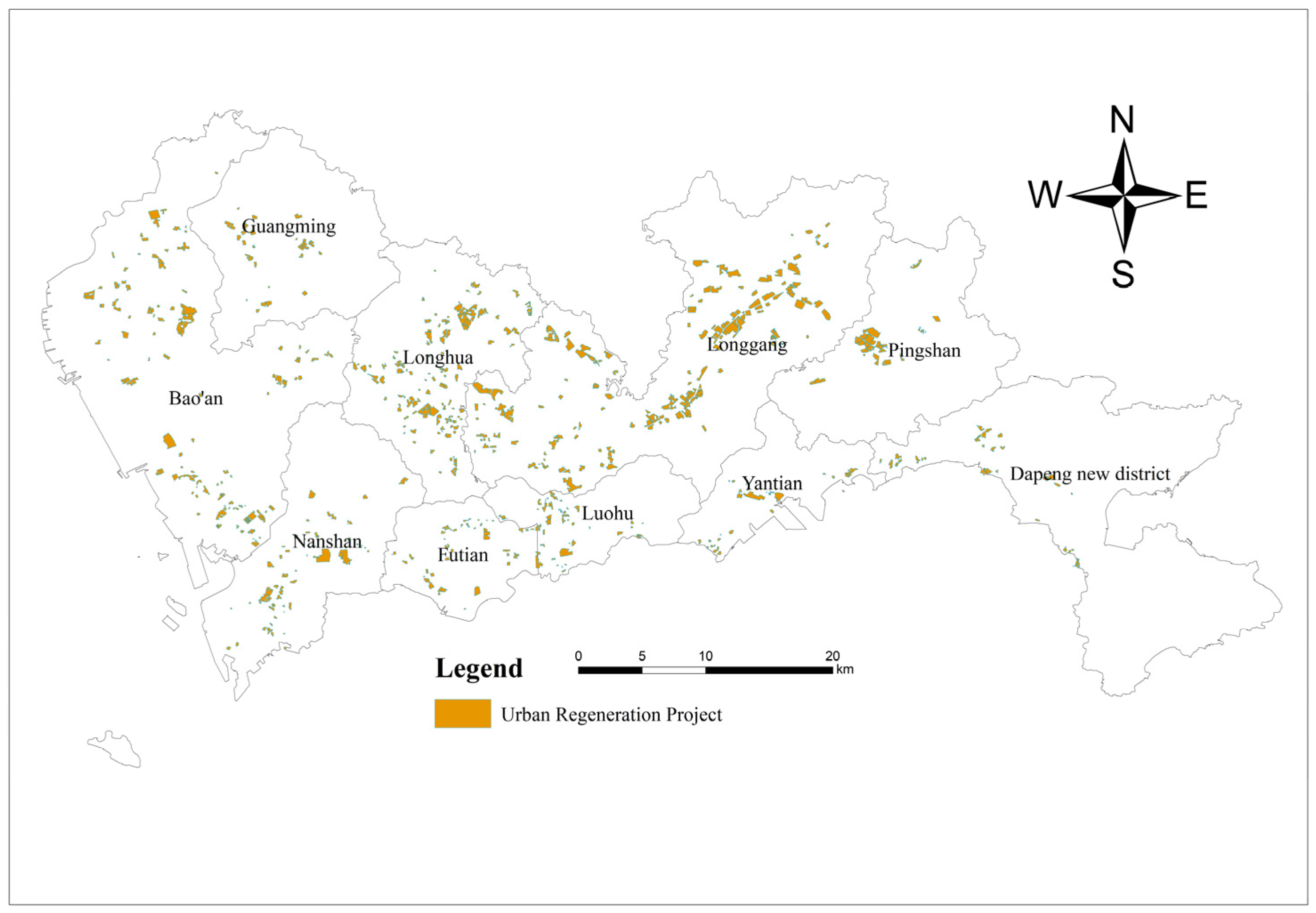
Appendix B
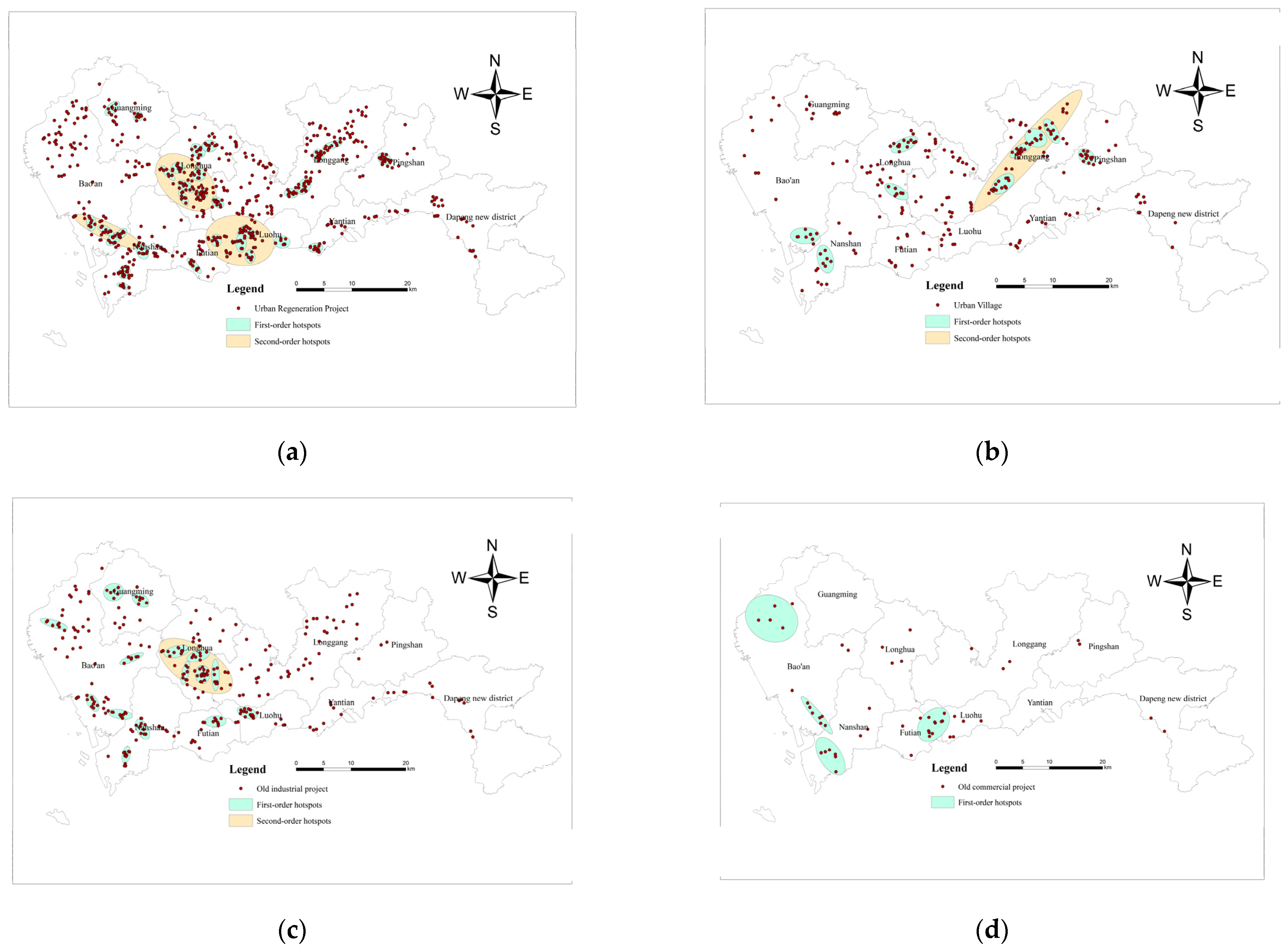
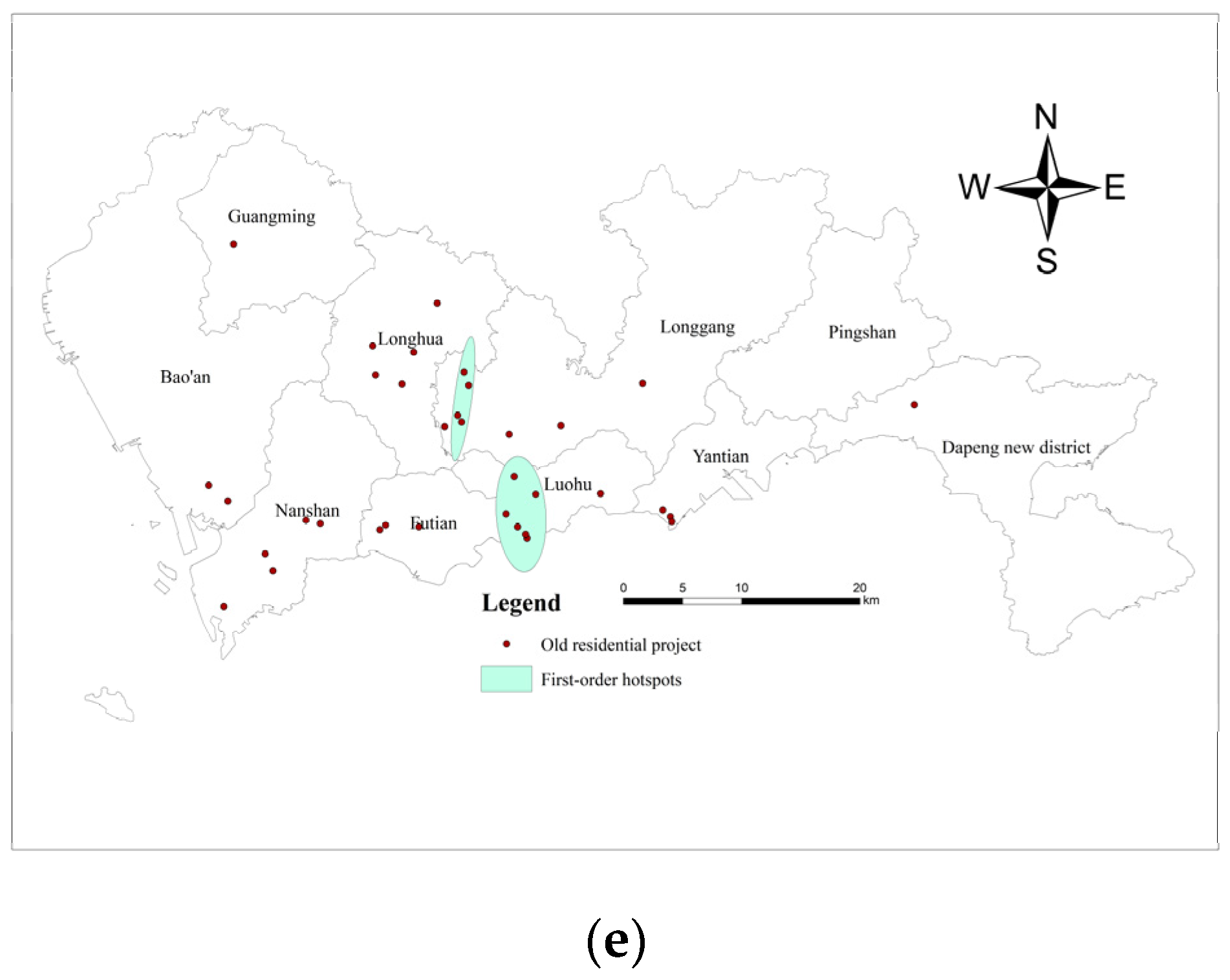
Appendix C

Appendix D

Appendix E


Appendix F
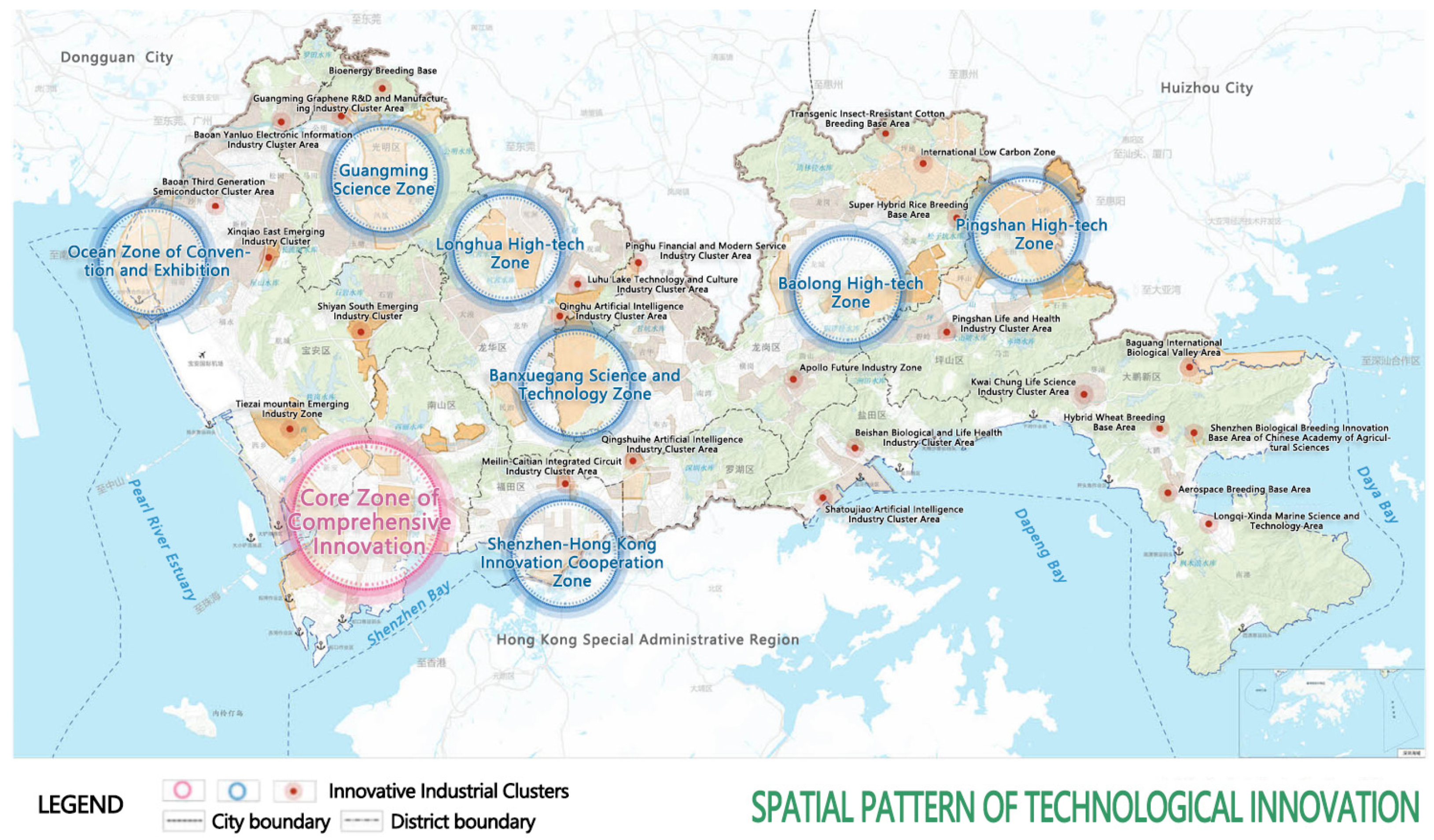
References
- Liu, G.; Fu, X.; Han, Q.; Huang, R.; Zhuang, T. Research on the collaborative governance of urban regeneration based on a Bayesian network: The case of Chongqing. Land Use Policy 2021, 109, 105640. [Google Scholar] [CrossRef]
- Zhang, W.; Zhang, X.X.; Wu, G.D. The network governance of urban renewal: A comparative analysis of two cities in China. Land Use Policy 2021, 106, 105448. [Google Scholar] [CrossRef]
- Wang, Q.; Su, M. The effects of urbanization and industrialization on decoupling economic growth from carbon emission—A case study of China. Sustain. Cities Soc. 2019, 51, 101758. [Google Scholar] [CrossRef]
- Lee, G.K.L.; Chan, E.H.W. Factors affecting urban renewal in high-density city: Case study of Hong Kong. J. Urban Plan. Dev. 2008, 134, 140–148. [Google Scholar] [CrossRef] [Green Version]
- Chen, M.X.; Liu, W.D.; Tao, X.L. Evolution and assessment on China’s urbanization 1960-2010: Under-urbanization or over-urbanization? Habitat Int. 2013, 38, 25–33. [Google Scholar] [CrossRef]
- Yi, Z.Y. Evaluation of Urban Renewal Benefits Based on the Collaborative Governance: A Case Study of Shenzhen; Chongqing University: Chongqing, China, 2018. [Google Scholar]
- Chan, E.; Lee, G.K.L. Critical factors for improving social sustainability of urban renewal projects. Soc. Indic. Res. 2008, 85, 243–256. [Google Scholar] [CrossRef]
- Zhuang, T.; Qian, Q.K.; Visscher, H.J.; Elsinga, M.G.; Wu, W. The role of stakeholders and their participation network in decision-making of urban renewal in China: The case of Chongqing. Cities 2019, 92, 47–58. [Google Scholar] [CrossRef]
- Couch, C. Urban Renewal: Theory and Practice; Macmillan International Higher Education: London, UK, 1990. [Google Scholar]
- Zheng, H.W.; Shen, G.Q.; Wang, H. A review of recent studies on sustainable urban renewal. Habitat Int. 2014, 41, 272–279. [Google Scholar] [CrossRef] [Green Version]
- Liu, G.W.; Wei, L.Z.; Gu, J.P.; Zhou, T.; Liu, Y. Benefit distribution in urban renewal from the perspectives of efficiency and fairness: A game theoretical model and the government’s role in China. Cities 2020, 96, 102422. [Google Scholar] [CrossRef]
- López-Contreras, N.; Puig-Barrachina, V.; Vives, A.; Olave-Müller, P.; Gotsens, M. Effects of an urban regeneration program on related social determinants of health in Chile: A pre-post intervention study. Health Place 2021, 68, 102511. [Google Scholar] [CrossRef]
- Zhu, S.; Li, D.; Feng, H.; Gu, T.; Zhu, J. AHP-TOPSIS-Based Evaluation of the Relative Performance of Multiple Neighborhood Renewal Projects: A Case Study in Nanjing, China. Sustainability 2019, 11, 4545. [Google Scholar] [CrossRef] [Green Version]
- Domestic Urban Renewal Market Size Has Entered the 10 Trillion Level. Available online: https://www.sohu.com/a/472310781_120649088 (accessed on 2 March 2022).
- Central City Work Conference Held in Beijing. Available online: http://www.xinhuanet.com//politics/2015-12/22/c_1117545528.htm (accessed on 2 March 2022).
- Central Economic Work Conference Held in Beijing. Available online: http://www.ce.cn/xwzx/gnsz/szyw/201912/12/t20191212_33843266.shtml (accessed on 2 March 2022).
- Proposal of the Central Committee of the Communist Party of China on Formulating the 14th Five-Year Plan for National Economic and Social Development and the 2035 Visionary Goals. Available online: http://www.gov.cn/xinwen/2021-03/13/content_5592681.htm (accessed on 2 March 2022).
- Leary, M.E.; McCarthy, J. Introduction: Urban Regeneration, a Global Phenomenon. In The Routledge Companion to Urban Regeneration; Routledge: London, UK, 2013; pp. 21–34. [Google Scholar]
- Zewdie, M.; Worku, H.; Bantider, A. Inner City Urban Renewal: Assessing the Sustainability and Implications for Urban Landscape Change of Addis Ababa. J. Hous. Built Environ. 2021, 36, 1249–1275. [Google Scholar] [CrossRef]
- La Rosa, D.; Privitera, R.; Barbarossa, L.; La Greca, P. Assessing spatial benefits of urban regeneration programs in a highly vulnerable urban context: A case study in Catania, Italy. Landsc. Urban Plan. 2017, 157, 180–192. [Google Scholar] [CrossRef]
- Lan, C.I.C.; Lee, C.-J. Property-led renewal, state-induced rent gap, and the sociospatial unevenness of sustainable regeneration in Taipei. Hous. Stud. 2021, 36, 843–866. [Google Scholar] [CrossRef]
- Greene, M.; Mora, R.I.; Figueroa, C.; Waintrub, N.; de D. Ortúzar, J. Towards a sustainable city: Applying urban renewal incentives according to the social and urban characteristics of the area. Habitat Int. 2017, 68, 15–23. [Google Scholar] [CrossRef]
- Larsen, H.G.; Hansen, A.L. Gentrification-Gentle or Traumatic? Urban Renewal Policies and Socioeconomic Transformations in Copenhagen. Urban Stud. 2008, 45, 2429–2448. [Google Scholar] [CrossRef] [Green Version]
- Mehdipanah, R.; Marra, G.; Melis, G.; Gelormino, E. Urban renewal, gentrification and health equity: A realist perspective. Eur. J. Public Health 2018, 28, 243–248. [Google Scholar] [CrossRef] [PubMed] [Green Version]
- Hatz, G. Can public subsidized urban renewal solve the gentrification issue? Dissecting the Viennese example. Cities 2021, 115, 103218. [Google Scholar] [CrossRef]
- Eom, S.; Suzuki, T. Spatial distribution of pedestrian space in central Tokyo Regarding building, public transportation and urban renewal projects. Int. Rev. Spat. Plan. Sustain. Dev. 2019, 7, 108–124. [Google Scholar] [CrossRef] [Green Version]
- Pinnegar, S.; Randolph, B.; Troy, L. Decoupling Growth from Growth-dependent Planning Paradigms: Contesting Prevailing Urban Renewal Futures in Sydney, Australia. Urban Policy Res. 2020, 38, 321–337. [Google Scholar] [CrossRef]
- Zuo, J.; Dong, J.; Li, C. Environmental Research on Eco-complex Network System Construction in High-density Areas based on Urban Regeneration. Ekoloji 2018, 27, 1479–1491. [Google Scholar]
- Xiang, P.C.; Wang, Y.M.; Deng, Q. Research on Urban Renewal from the Perspective of Natural Disaster Vulnerability. In Proceedings of the 9th International Conference on Sustainable Development and Planning, Bristol, UK, 27–29 June 2017; pp. 85–93. [Google Scholar]
- Baeten, G.; Westin, S.; Pull, E.; Molina, I. Pressure and violence: Housing renovation and displacement in Sweden. Environ. Plan. a-Econ. Space 2017, 49, 631–651. [Google Scholar] [CrossRef] [Green Version]
- Yi, Z.; Liu, G.; Lang, W.; Shrestha, A.; Martek, I. Strategic Approaches to Sustainable Urban Renewal in Developing Countries: A Case Study of Shenzhen, China. Sustainability 2017, 9, 1460. [Google Scholar] [CrossRef] [Green Version]
- Geng, H. The analysis of the main problems came from the urban renewal of the Chinese major cities in the 1990s. City Plan. Rev. 1999, 7, 13–17. [Google Scholar]
- Yazar, M.; Hestad, D.; Mangalagiu, D.; Saysel, A.K.; Ma, Y.; Thornton, T.F. From urban sustainability transformations to green gentrification: Urban renewal in Gaziosmanpasa, Istanbul. Clim. Chang. 2020, 160, 637–653. [Google Scholar] [CrossRef]
- Ye, L. Urban regeneration in China: Policy, development, and issues. Local Econ. 2011, 26, 337–347. [Google Scholar] [CrossRef]
- Zhou, Y.; Chang, J. Imitation, Reference, and Exploration-Development Path to Urban Renewal in China (1985-2017). J. Urban Hist. 2020, 46, 728–746. [Google Scholar] [CrossRef]
- He, S.; Wu, F. Property-Led Redevelopment in Post-Reform China: A Case Study of Xintiandi Redevelopment Project in Shanghai. J. Urban Aff. 2005, 27, 1–23. [Google Scholar] [CrossRef]
- Lai, Y.N.; Tang, B.S.; Chen, X.S.; Zheng, X. Spatial determinants of land redevelopment in the urban renewal processes in Shenzhen, China. Land Use Policy 2021, 103, 105330. [Google Scholar] [CrossRef]
- He, S. Three Waves of State-led Gentrification in China. Tijdschrift Voor Economische En Sociale Geografie 2019, 110, 26–34. [Google Scholar] [CrossRef]
- He, S.; Wu, F. China’s Emerging Neoliberal Urbanism: Perspectives from Urban Redevelopment. Antipode 2009, 41, 282–304. [Google Scholar] [CrossRef]
- Ma, L.J.C. The Great Urban Transformation. Politics of Land and Property in China. Reg. Stud. 2010, 44, 1099–1100. [Google Scholar] [CrossRef]
- Colantonio, A.; Lane, G. Measuring Social Sustainability, Best Practice from Urban Renewal in the EU, 2007/01: EIBURS Working Paper Series; Oxford Institute for Sustainable Development (OISD)–International Land Markets Group: Oxford, UK, 2007. [Google Scholar]
- Xie, F.; Liu, G.; Zhuang, T. A Comprehensive Review of Urban Regeneration Governance for Developing Appropriate Governance Arrangements. Land 2021, 10, 545. [Google Scholar] [CrossRef]
- Wang, H.; Shen, Q.P.; Tang, B.S. GIS-Based Framework for Supporting Land Use Planning in Urban Renewal: Case Study in Hong Kong. J. Urban Plan. Dev. 2015, 141, 05014015. [Google Scholar] [CrossRef]
- Liu, G.W.; Chen, S.J.; Gu, J.P. Urban renewal simulation with spatial, economic and policy dynamics: The rent-gap theory-based model and the case study of Chongqing. Land Use Policy 2019, 86, 238–252. [Google Scholar] [CrossRef]
- Xu, Y.Y.; Liu, M.; Hu, Y.M.; Li, C.L.; Xiong, Z.P. Analysis of Three-Dimensional Space Expansion Characteristics in Old Industrial Area Renewal Using GIS and Barista: A Case Study of Tiexi District, Shenyang, China. Sustainability 2019, 11, 1860. [Google Scholar] [CrossRef] [Green Version]
- Perez, M.G.R.; Laprise, M.; Rey, E. Fostering sustainable urban renewal at the neighborhood scale with a spatial decision support system. Sustain. Cities Soc. 2018, 38, 440–451. [Google Scholar] [CrossRef]
- Cui, J.Q.; Broere, W.; Lin, D. Underground space utilisation for urban renewal. Tunn. Undergr. Space Technol. 2021, 108, 103726. [Google Scholar] [CrossRef]
- Thorne, J.H.; Choe, H.; Boynton, R.M.; Lee, D.K. Open space networks can guide urban renewal in a megacity. Environ. Res. Lett. 2020, 15, 094080. [Google Scholar] [CrossRef]
- Wang, J.; Zhou, W.Q.; Wang, J.; Yu, W.J. Spatial distribution of urban greenspace in response to urban development from a multi-scale perspective. Environ. Res. Lett. 2020, 15, 064031. [Google Scholar] [CrossRef]
- Yue, W.Z.; Xu, J.H.; Wu, J.W.; Xu, L.H. Remote sensing of spatial patterns of urban renewal using linear spectral mixture analysis: A case of central urban area of Shanghai (1997–2000). Chin. Sci. Bull. 2006, 51, 977–986. [Google Scholar] [CrossRef]
- Lai, Y.N.; Jiang, L.; Xu, X.X. Exploring Spatio-Temporal Patterns of Urban Village Redevelopment: The Case of Shenzhen, China. Land 2021, 10, 976. [Google Scholar] [CrossRef]
- Tong, D.; Feng, C.C.; Li, G.C.; Chen, P. Categories and characteristics of urban villages by GIS-based analysis: A case study of the Shenzhen Special Economic Zone. Sci. China-Technol. Sci. 2010, 53, 150–157. [Google Scholar] [CrossRef]
- Chen, X.; Pei, Z.; Chen, A.L.; Wang, F.; Shen, K.; Zhou, Q.; Sun, L. Spatial Distribution Patterns and Influencing Factors of Poverty—A Case Study on Key Country From National Contiguous Special Poverty-stricken Areas in China. Procedia Environ. Sci. 2015, 26, 82–90. [Google Scholar] [CrossRef] [Green Version]
- Guo, A.D.; Yang, J.; Xiao, X.M.; Xia, J.H.; Jin, C.; Li, X.M. Influences of urban spatial form on urban heat island effects at the community level in China. Sustain. Cities Soc. 2020, 53, 101972. [Google Scholar] [CrossRef]
- Boix, R.; Luis Hervas-Oliver, J.; De Miguel-Molina, B. Micro-geographies of creative industries clusters in Europe: From hot spots to assemblages. Pap. Reg. Sci. 2015, 94, 753–772. [Google Scholar] [CrossRef]
- Manuel Gasca-Sanchez, F.; Santos-Guzman, J.; Elizondo-Duenaz, R.; Manuel Mejia-Velazquez, G.; Ruiz-Pacheco, C.; Reyes-Rodriguez, D.; Vazquez-Camacho, E.; Ascencion Hernandez-Hernandez, J.; del Carmen Lopez-Sanchez, R.; Ortiz-Lopez, R.; et al. Spatial Clusters of Children with Cleft Lip and Palate and Their Association with Polluted Zones in the Monterrey Metropolitan Area. Int. J. Environ. Res. Public Health 2019, 16, 2488. [Google Scholar] [CrossRef] [Green Version]
- Steiniger, S.; Weibel, R. Relations among Map Objects in Cartographic Generalization. Cartogr. Geogr. Inf. Sci. 2007, 34, 175–197. [Google Scholar] [CrossRef]
- Gasca-Sanchez, F.M.; Santuario-Facio, S.K.; Ortiz-Lopez, R.; Rojas-Martinez, A.; Mejia-Velazquez, G.M.; Garza-Perez, E.M.; Hernandez-Hernandez, J.A.; Lopez-Sanchez, R.D.C.; Cardona-Huerta, S.; Santos-Guzman, J. Spatial interaction between breast cancer and environmental pollution in the Monterrey Metropolitan Area. Heliyon 2021, 7, e07915. [Google Scholar] [CrossRef] [PubMed]
- Xu, B.; Pan, J. Analysis of structural characteristics and spatial distribution of the national intangible cultural heritage in China and its policy implications. Sci. Cold Arid. Reg. 2019, 11, 389–406. [Google Scholar]
- Yuan, C.; Duan, Y.; Mao, X.; Ma, N.; Zhao, J. Impact of the mixed degree of urban functions on the taxi travel demand. PLoS ONE 2021, 16, 0247431. [Google Scholar] [CrossRef]
- Zhao, F.; Fu, Y.; Luan, G.Z.; Zhang, S.J.; Cai, J.Z.; Ding, J.Y.; Qian, J.K.; Xie, Z.A. Spatial-Temporal Characteristic Analysis of Ethnic Toponyms Based on Spatial Information Entropy at the Rural Level in Northeast China. Entropy 2020, 22, 393. [Google Scholar] [CrossRef] [PubMed] [Green Version]
- Pan, J.X.; Huang, W.L.; Li, X.; Li, R.Y. Spatial distribution and regional accessibility measurement of financial services in china. Arab. J. Geosci. 2021, 14, 1696. [Google Scholar] [CrossRef]
- Larson, A.J.; Churchill, D. Tree spatial patterns in fire-frequent forests of western North America, including mechanisms of pattern formation and implications for designing fuel reduction and restoration treatments. For. Ecol. Manag. 2012, 267, 74–92. [Google Scholar] [CrossRef]
- Maroko, A.R.; Nash, D.; Pavilonis, B.T. COVID-19 and Inequity: A Comparative Spatial Analysis of New York City and Chicago Hot Spots. J. Urban Health Bull. N. Y. Acad. Med. 2020, 97, 461–470. [Google Scholar] [CrossRef] [PubMed]
- Fu, Y.; Yang, X.M.; Wang, T.; Supriyadi, A.; Cirella, G.T. Spatial Pattern Characteristics of the Financial Service Industry: Evidence from Nanjing, China. Appl. Spat. Anal. Policy 2021, 14, 1–26. [Google Scholar] [CrossRef]
- Yue, Y.; Zhuang, Y.; Yeh, A.G.O.; Xie, J.-Y.; Ma, C.-L.; Li, Q.-Q. Measurements of POI-based mixed use and their relationships with neighborhood vibrancy. Int. J. Geogr. Inf. Sci. 2017, 31, 658–675. [Google Scholar] [CrossRef] [Green Version]
- Sarkar, P.P.; Chunchu, M. Quantification and Analysis of Land-Use Effects on Travel Behavior in Smaller Indian Cities: Case Study of Agartala. J. Urban Plan. Dev. 2016, 142, 04016009. [Google Scholar] [CrossRef]
- Xu, L.; Wang, Y.; Xu, Y.; Zhou, Y.; Wang, Z. Spatial Structure of Housing Prices in Nanchang, China. In Proceedings of the 2016 International Conference on Applied Mathematics, Simulation and Modelling, Beijing, China, 28–29 May 2016; pp. 456–459. [Google Scholar]
- Jerrett, M.; Burnett, R.T.; Beckerman, B.S.; Turner, M.C.; Krewski, D.; Thurston, G.; Martin, R.V.; van Donkelaar, A.; Hughes, E.; Shi, Y.L.; et al. Spatial Analysis of Air Pollution and Mortality in California. Am. J. Respir. Crit. Care Med. 2013, 188, 593–599. [Google Scholar] [CrossRef] [Green Version]
- Xu, Y.; Chen, X. Quantitative analysis of spatial vitality and spatial characteristics of urban underground space (UUS) in metro area. Tunn. Undergr. Space Technol. 2021, 111, 103875. [Google Scholar] [CrossRef]
- van Nes, A. Spatial Configurations and Walkability Potentials. Measuring Urban Compactness with Space Syntax. Sustainability 2021, 13, 5785. [Google Scholar] [CrossRef]
- Yuan, J.F.; Bian, Z.F.; Yan, Q.W.; Pan, Y.Q. Spatio-Temporal Distributions of the Land Use Efficiency Coupling Coordination Degree in Mining Cities of Western China. Sustainability 2019, 11, 5288. [Google Scholar] [CrossRef] [Green Version]
- Zhang, Y.J.; Su, Z.G.; Li, G.; Zhuo, Y.F.; Xu, Z.G. Spatial-Temporal Evolution of Sustainable Urbanization Development: A Perspective of the Coupling Coordination Development Based on Population, Industry, and Built-Up Land Spatial Agglomeration. Sustainability 2018, 10, 1766. [Google Scholar] [CrossRef] [Green Version]
- Xu, D.; Hou, G.L. The Spatiotemporal Coupling Characteristics of Regional Urbanization and Its Influencing Factors: Taking the Yangtze River Delta as an Example. Sustainability 2019, 11, 822. [Google Scholar] [CrossRef] [Green Version]
- Zhou, L.; Dang, X.W.; Sun, Q.K.; Wang, S.H. Multi-scenario simulation of urban land change in Shanghai by random forest and CA-Markov model. Sustain. Cities Soc. 2020, 55, 102045. [Google Scholar] [CrossRef]
- Gallage, S.D.; Devapriya, K.A.K.; Perera, B.A.K.S. A framework for the better integration of the crucial economic factors of Sri Lankan urban renewal projects. Intell. Build. Int. 2021, 13, 1–19. [Google Scholar] [CrossRef]
- Della Spina, L.; Calabro, F.; Rugolo, A. Social Housing: An Appraisal Model of the Economic Benefits in Urban Regeneration Programs. Sustainability 2020, 12, 609. [Google Scholar] [CrossRef] [Green Version]
- Baum-Snow, N.; Brandt, L.; Henderson, J.V.; Turner, M.A.; Zhang, Q.H. Roads, Railroads, and Decentralization of Chinese Cities. Rev. Econ. Stat. 2017, 99, 435–448. [Google Scholar] [CrossRef]
- Clark, P.J.; Evans, F.C. Distance to Nearest Neighbor as a Measure of Spatial Relationships in Populations. Ecology 1954, 35, 445–453. [Google Scholar] [CrossRef]
- Jia, Z.; Zhou, S.; Su, Q.; Yi, H.; Wang, J. Comparison Study on the Estimation of the Spatial Distribution of Regional Soil Metal(loid)s Pollution Based on Kriging Interpolation and BP Neural Network. Int. J. Environ. Res. Public Health 2018, 15, 34. [Google Scholar] [CrossRef] [PubMed] [Green Version]
- Hillier, B. Space Is the Machine: A Configurational Theory of Architecture; Space Syntax: London, UK, 1996. [Google Scholar]
- Giannopoulou, M.; Roukounis, Y.; Stefanis, V. Traffic Network and the Urban Environment: An Adapted Space Syntax Approach. Procedia—Soc. Behav. Sci. 2012, 48, 1887–1896. [Google Scholar] [CrossRef] [Green Version]
- Xia, C.; Zhang, A.; Wang, H.; Yeh, A.G.O. Predicting the expansion of urban boundary using space syntax and multivariate regression model. Habitat Int. 2019, 86, 126–134. [Google Scholar] [CrossRef]
- Silverman, B.W. Density Estimation for Statistics and Data Analysis; Routledge: New York, NY, USA, 2018. [Google Scholar]
- Luo, G.; Wang, B.; Luo, D.; Wei, C. Spatial Agglomeration Characteristics of Rural Settlements in Poor Mountainous Areas of Southwest China. Sustainability 2020, 12, 1818. [Google Scholar] [CrossRef] [Green Version]
- Ma, M.; Wu, Y.; Chen, L.; Li, J.; Jing, N. Interactive and Online Buffer-Overlay Analytics of Large-Scale Spatial Data. Isprs Int. J. Geo-Inf. 2019, 8, 21. [Google Scholar] [CrossRef] [Green Version]
- Shenzhen Planning and Natural Resources Bureau. Shenzhen Territorial Spatial Master Plan (2020–2035). Available online: http://www.sz.gov.cn/cn/xxgk/zfxxgj/tzgg/content/post_8858878.html (accessed on 2 March 2022).
- Liu, G.; Yi, Z.; Zhang, X.; Shrestha, A.; Martek, I.; Wei, L. An Evaluation of Urban Renewal Policies of Shenzhen, China. Sustainability 2017, 9, 1001. [Google Scholar] [CrossRef] [Green Version]
- Hao, P.; Sliuzas, R.; Geertman, S. The development and redevelopment of urban villages in Shenzhen. Habitat Int. 2011, 35, 214–224. [Google Scholar] [CrossRef]
- Star, J.; Estes, J. Geographic information systems: An introduction. Geocarto Int. 1991, 6, 46. [Google Scholar] [CrossRef]
- Lai, Y.; Chen, K.; Zhang, J.; Liu, F. Transformation of Industrial Land in Urban Renewal in Shenzhen, China. Land 2020, 9, 371. [Google Scholar] [CrossRef]
- Deng, Y.; Fu, B.J.; Sun, C.Z. Effects of urban planning in guiding urban growth: Evidence from Shenzhen, China. Cities 2018, 83, 118–128. [Google Scholar] [CrossRef]
- Charles, S.L. The spatio-temporal pattern of housing redevelopment in suburban Chicago, 2000–2010. Urban Stud. 2014, 51, 2646–2664. [Google Scholar] [CrossRef]
- Frantal, B.; Greer-Wootten, B.; Klusacek, P.; Krejci, T.; Kunc, J.; Martinat, S. Exploring spatial patterns of urban brownfields regeneration: The case of Brno, Czech Republic. Cities 2015, 44, 9–18. [Google Scholar] [CrossRef]
- Bacot, H.; O’Dell, C. Establishing indicators to evaluate brownfield redevelopment. Econ. Dev. Q. 2006, 20, 142–161. [Google Scholar] [CrossRef]
- Wang, H.; Zhao, Y.; Gao, X.; Gao, B. Collaborative decision-making for urban regeneration: A literature review and bibliometric analysis. Land Use Policy 2021, 107, 105479. [Google Scholar] [CrossRef]
- Shamai, M.; Hananel, R. One + One + One = A lot: The cumulative effect of Israel’s flagship urban renewal policy on neighborhood diversity. Land Use Policy 2021, 100, 104916. [Google Scholar] [CrossRef]
- Li, L. State or market: The role of the government in urban village regeneration in China. Int. J. Urban Sci. 2015, 19, 157–167. [Google Scholar] [CrossRef]
- Wang, Y.; Wu, J.; Zhou, M. Urban Renewal and Local Economy: Debates, Reflections and Insights in the Context of the Globalization Crisis. Int. Urban Plan. 2020, 35, 1–8. [Google Scholar]
- Krugman, P. Increasing returns and economic geography. J. Political Econ. 1991, 99, 483–499. [Google Scholar] [CrossRef]
- Garcia-Lopez, M.-A. Population suburbanization in Barcelona, 1991–2005: Is its spatial structure changing? J. Hous. Econ. 2010, 19, 119–132. [Google Scholar] [CrossRef]
- Cuadrado-Ciuraneta, S.; Durà-Guimerà, A.; Salvati, L. Not only tourism: Unravelling suburbanization, second-home expansion and “rural” sprawl in Catalonia, Spain. Urban Geogr. 2017, 38, 66–89. [Google Scholar] [CrossRef]
- Perroux, F. Note sur la Notion de" Pôle de Croissance". Economie Appliquée 1955, 8, 307–320. [Google Scholar]
- Porter, M.E. The competitive advantage of nations. Compet. Intell. Rev. 1990, 1, 14. [Google Scholar] [CrossRef]
- Bureau, S.S. Shenzhen Seventh National Census Bulletin. Available online: http://tjj.sz.gov.cn/ztzl/zt/szsdqcqgrkpc/szrp/content/post_8772112.html (accessed on 2 March 2022).
- He, Y.; Tang, C.; Zhou, G.; He, S.; Qiu, Y.; Shi, L.; Zhang, H. Spatial Conflict Measurement in Rapidly Urbanizing Regions Based on Geography Perspective: An Example of Chang-Zhu-Tan City Cluster Region. J. Nat. Resour. 2014, 29, 1660–1674. [Google Scholar]
- Savills. Greater Bay Area Grade A Office Index for the First Half of 2021. Available online: https://www.savills.com.cn/research_articles/166704/203017-0 (accessed on 2 March 2022).
- Engel, J.S.; Berbegal-Mirabent, J.; Pique, J.M. The renaissance of the city as a cluster of innovation. Cogent Bus. Manag. 2018, 5, 1–20. [Google Scholar] [CrossRef]
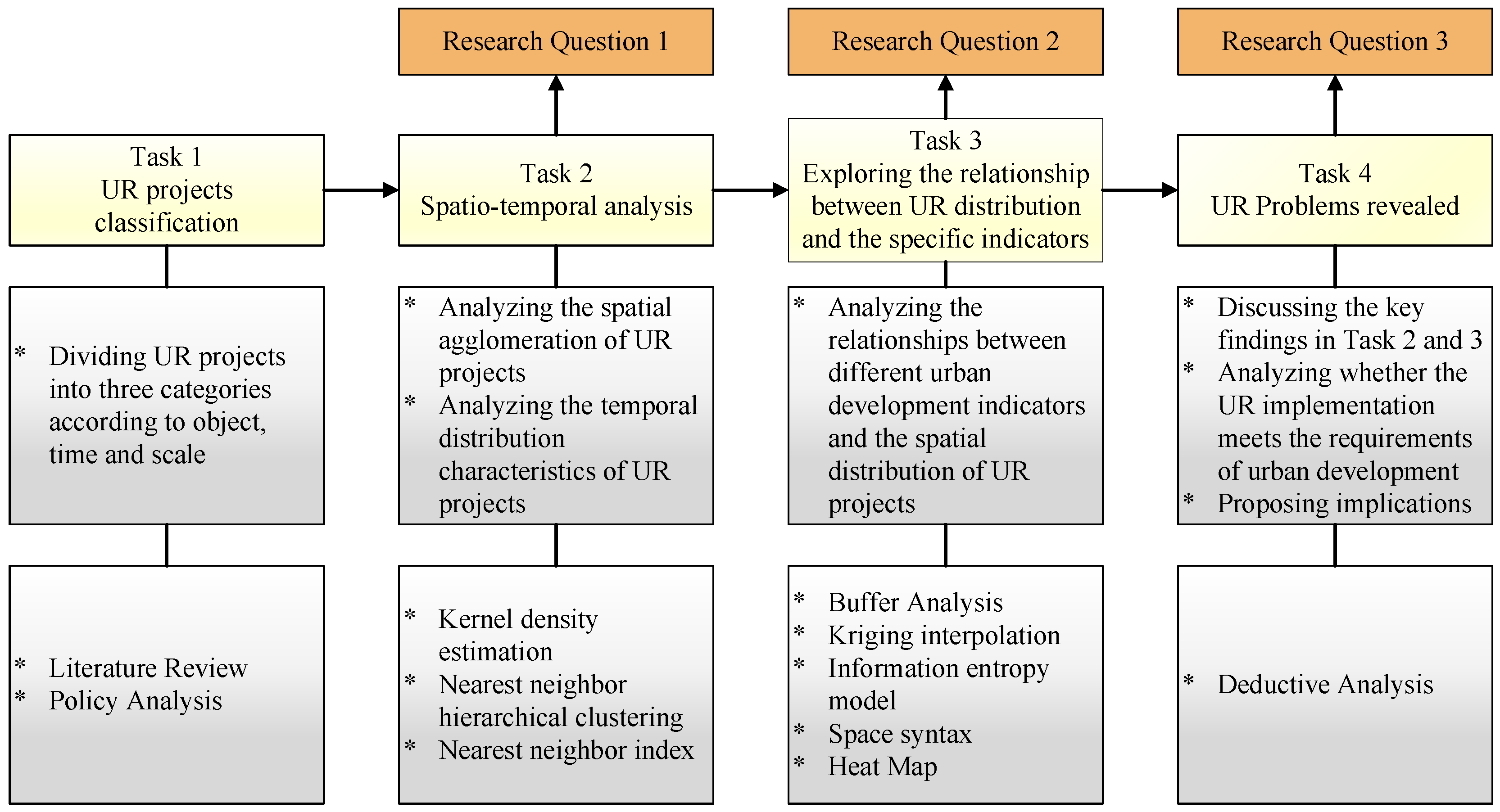

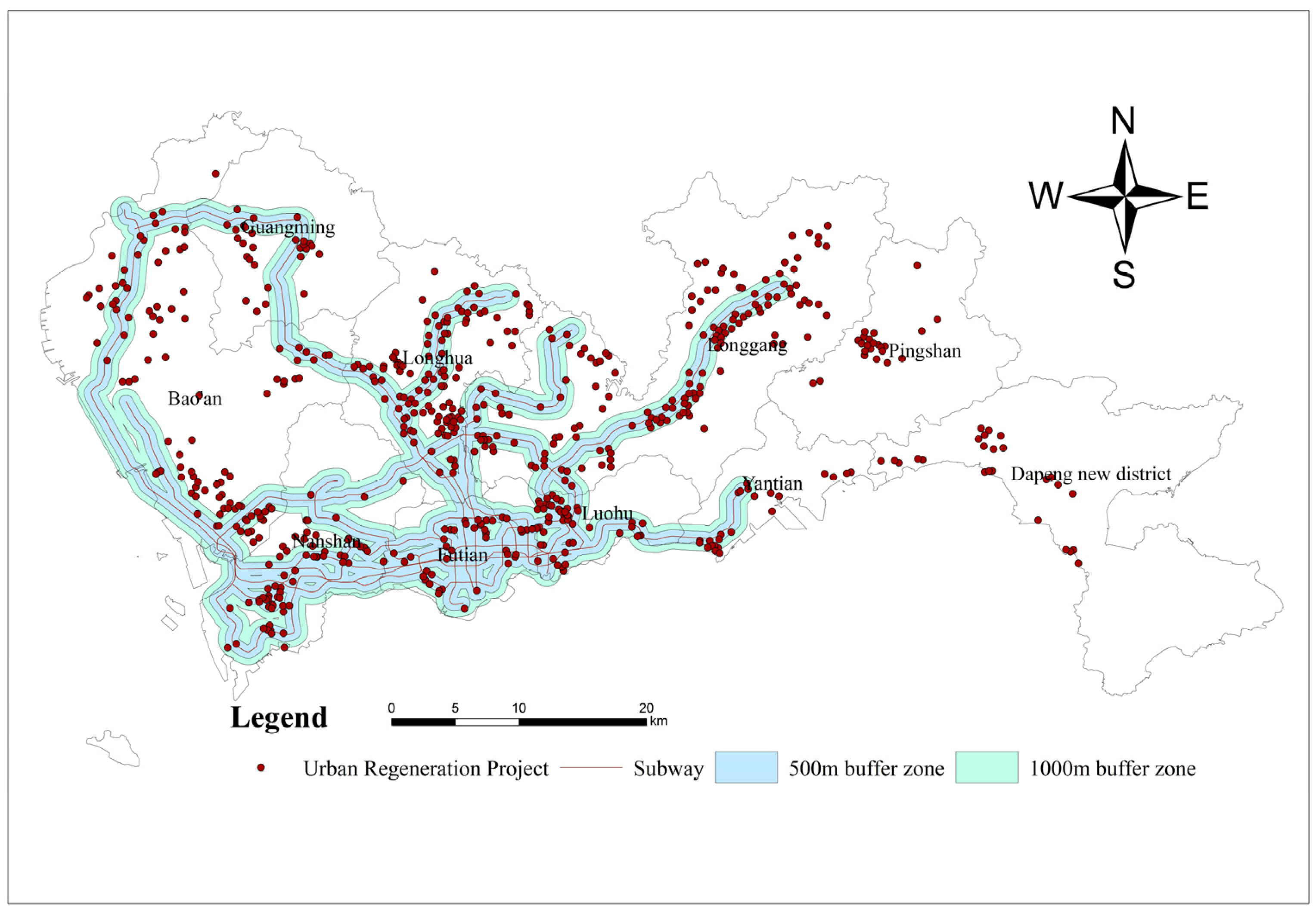




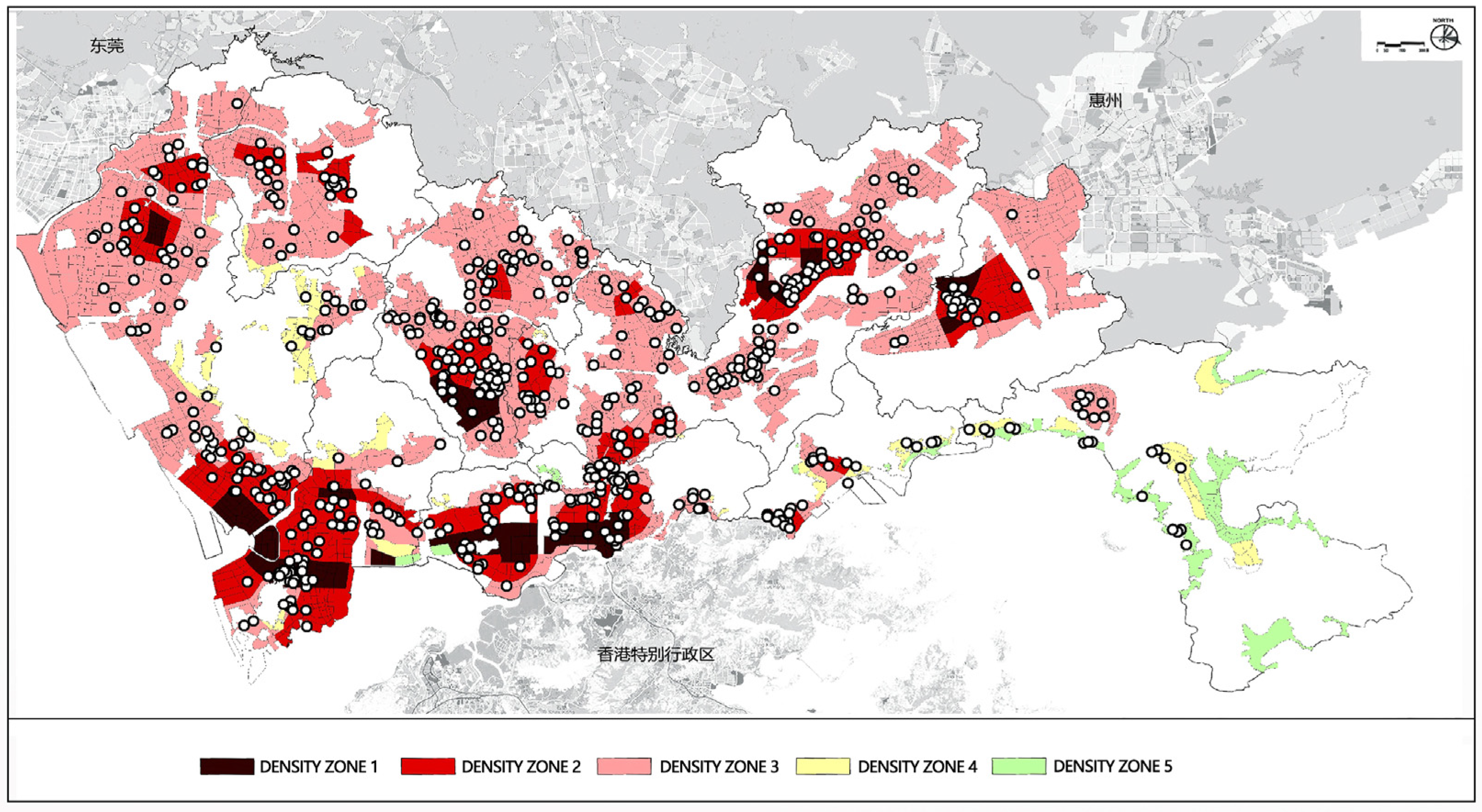
| Methods | Function | Source |
|---|---|---|
| Moran’s I | Analyzing the spatial autocorrelation of attribute values | [53,54] |
| Nearest Neighbor Index (NNI) | Measuring the degree of spatial data clustering | [55,56,57] |
| Nearest Neighbor Hierarchy Clustering (NNHC) | Analyzing the hot spots of elements by clustering spatial elements | [58,59] |
| Kernel density | Analyzing the agglomeration of elements by calculating the density of spatial elements in the surrounding areas | [60,61,62] |
| Ripley’s K Function | Analyzing the degree of spatial aggregation or diffusion of centroid feature | [63] |
| Getis-Ord | Analyzing hot and cold spots in the particular space | [64] |
| Standard ellipse difference | Estimating distribution trends and central locations of spatial elements | [61,62,65] |
| Information entropy model | Assessing the degree of the mixing of spatial elements | [60,66,67] |
| Spatial interpolation | Estimating the data of unknown points from the data of known points | [68,69] |
| Space syntax | Dividing the space and analyzing its complex relationships | [70,71] |
| Data | Source | URL |
|---|---|---|
| UR Projects | Shenzhen UR Projects Information | http://csgx.szhome.com/ (accessed on 24 March 2021) |
| Road Network | National Catalogue Service for Geographic Information | https://www.webmap.cn/main.do?method=index (accessed on 14 July 2021) |
| Density Partition of Built-up area | Portal of Shenzhen Municipal Government | http://www.sz.gov.cn/cn/xxgk/zfxxgj/zcfg/szsfg/content/post_6580490.html (accessed on 18 July 2021) |
| House Prices | Lianjia official portal | https://sz.lianjia.com/xiaoqu/cro21/ (accessed on 15 July 2021) |
| Metro | Amap | https://www.amap.com/ |
| POI | (accessed on 12 February 2021) | |
| Population Heat Map | Baidu Maps | https://map.baidu.com/@11854652,3430240,13z (accessed on 18 July 2021) |
| Type | Sample Size | Observation Distance/m | Expectation Distance/m | NNI | z-Value | p-Value | Distribution Type |
|---|---|---|---|---|---|---|---|
| All | 620 | 560.7595 | 893.23833 | 0.627783 | −17.7306 | 0 | Agglomeration |
| UV | 229 | 919.6744 | 1469.75672 | 0.625732 | −10.835 | 0 | Agglomeration |
| OI | 292 | 802.2145 | 1301.582707 | 0.616338 | −12.5421 | 0 | Agglomeration |
| OC | 53 | 1731.234 | 3055.098809 | 0.56667 | −6.03514 | 0 | Agglomeration |
| OR | 35 | 2892.054 | 3759.492074 | 0.769267 | −2.61141 | 0.009017 | Agglomeration |
| MU | 11 | 5644.881 | 6706.051019 | 0.841759 | −1.00403 | 0.315366 | Agglomeration |
| Type | Before 2010 | 2011 | 2012 | 2013 | 2014 | 2015 | 2016 | 2017 | 2018 | 2019 | 2020 | 2021 | Total |
|---|---|---|---|---|---|---|---|---|---|---|---|---|---|
| UV | 87 | 8 | 19 | 9 | 14 | 26 | 20 | 1 | 14 | 21 | 10 | 0 | 229 |
| OI | 38 | 37 | 30 | 9 | 25 | 33 | 28 | 6 | 43 | 26 | 16 | 1 | 292 |
| OC | 11 | 5 | 6 | 6 | 7 | 5 | 1 | 1 | 7 | 2 | 2 | 0 | 53 |
| OR | 10 | 3 | 3 | 1 | 1 | 0 | 2 | 1 | 9 | 0 | 4 | 1 | 35 |
| MU | 4 | 1 | 3 | 2 | 0 | 0 | 1 | 0 | 0 | 0 | 0 | 0 | 11 |
| Total | 150 | 54 | 61 | 27 | 47 | 64 | 52 | 9 | 73 | 49 | 32 | 2 | 620 |
| Types | OI | UV | OR | OC | MU | Total | Proportion |
|---|---|---|---|---|---|---|---|
| less than 50,000 m2 | 176 | 71 | 17 | 37 | 1 | 302 | 49.11% |
| between 50,000 and 100,000 m2 | 62 | 69 | 14 | 10 | 3 | 158 | 25.69% |
| larger than 100,000 m2 | 51 | 87 | 4 | 6 | 7 | 155 | 25.20% |
| Total | 289 | 227 | 35 | 53 | 11 | 615 | 100% |
| Types | Total | 500 m | Percentage | 1000 m | Percentage |
|---|---|---|---|---|---|
| UV | 229 | 75 | 33% | 133 | 58% |
| OI | 292 | 112 | 38% | 171 | 59% |
| OC | 53 | 29 | 55% | 38 | 72% |
| OR | 35 | 18 | 51% | 28 | 80% |
| MU | 11 | 7 | 64% | 9 | 82% |
| Total | 620 | 241 | 38.9% | 379 | 61.1% |
| Heat Value Classification | Total | UV | OI | OC | OR | MU |
|---|---|---|---|---|---|---|
| 0 | 3 | 1 | 2 | 0 | 0 | 0 |
| 1 | 57 | 26 | 27 | 2 | 2 | 0 |
| 2 | 16 | 7 | 9 | 0 | 0 | 0 |
| 3 | 48 | 20 | 23 | 3 | 2 | 0 |
| 4 | 63 | 27 | 30 | 4 | 1 | 1 |
| 5 | 57 | 22 | 32 | 1 | 1 | 1 |
| 6 | 143 | 46 | 72 | 14 | 7 | 4 |
| 7 | 233 | 80 | 97 | 29 | 22 | 5 |
| Total | 620 | 229 | 292 | 53 | 35 | 11 |
| House Price | All | UV | OI | OC | OR | MU |
|---|---|---|---|---|---|---|
| Over 40,000 | 474 | 144 | 246 | 45 | 30 | 9 |
| Less than 40,000 | 146 | 85 | 46 | 8 | 5 | 2 |
| Total | 620 | 229 | 292 | 53 | 35 | 11 |
Publisher’s Note: MDPI stays neutral with regard to jurisdictional claims in published maps and institutional affiliations. |
© 2022 by the authors. Licensee MDPI, Basel, Switzerland. This article is an open access article distributed under the terms and conditions of the Creative Commons Attribution (CC BY) license (https://creativecommons.org/licenses/by/4.0/).
Share and Cite
Liu, G.; Li, C.; Zhuang, T.; Zheng, Y.; Wu, H.; Tang, J. Determining the Spatial Distribution Characteristics of Urban Regeneration Projects in China on the City Scale: The Case of Shenzhen. Land 2022, 11, 1210. https://doi.org/10.3390/land11081210
Liu G, Li C, Zhuang T, Zheng Y, Wu H, Tang J. Determining the Spatial Distribution Characteristics of Urban Regeneration Projects in China on the City Scale: The Case of Shenzhen. Land. 2022; 11(8):1210. https://doi.org/10.3390/land11081210
Chicago/Turabian StyleLiu, Guiwen, Cheng Li, Taozhi Zhuang, Yuhan Zheng, Hongjuan Wu, and Jian Tang. 2022. "Determining the Spatial Distribution Characteristics of Urban Regeneration Projects in China on the City Scale: The Case of Shenzhen" Land 11, no. 8: 1210. https://doi.org/10.3390/land11081210
APA StyleLiu, G., Li, C., Zhuang, T., Zheng, Y., Wu, H., & Tang, J. (2022). Determining the Spatial Distribution Characteristics of Urban Regeneration Projects in China on the City Scale: The Case of Shenzhen. Land, 11(8), 1210. https://doi.org/10.3390/land11081210







